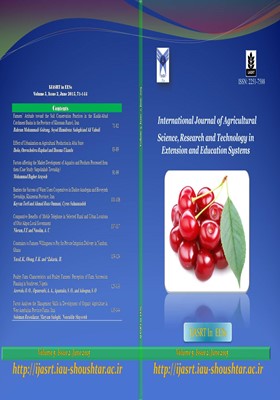Effect of Urbanization on Agricultural Production in Abia State
محورهای موضوعی : Agricultural ExtensionOnwuchekwa Raphael Iheke 1 , Ukandu Ihuoma 2
1 - Department of Agricultural Economics, Michael Okpara University of agriculture, Umudike
PMB 7267, Umuahia, Abia State, Nigeria
2 - Department of Agricultural Economics, Michael Okpara University of agriculture, Umudike
PMB 7267, Umuahia, Abia State, Nigeria
کلید واژه: production, Availability, agriculture, urbanization,
چکیده مقاله :
This study examined the effect of urbanization on agricultural production in Abia State. Specifically, it categorized the land tenancy status of the farmers, analyzed the effect of urbanization on agricultural productivity and identified the constraints to agricultural productivity. Multistage random sampling technique was used to select the respondents. Primary data collected using structured questionnaire and interview schedules were analyzed using frequency counts, means, and percentages and regression analysis. Results showed that majority (81.7%) of the respondents cultivated both on owned and rented farms. Only 10% and 8.3% of the respondents cultivating solely on owned and rented farm lands respectively. The regression result of the effect of urbanization and other factors on agricultural productivity showed that the significant variables influencing productivity were farm size, urbanization, fertilizer/ agrochemical, land tenure system, duration of land use and cost of farm land. The major constraints to increased productivity as noted by the respondents based on their degree of effect were lack of capital for agricultural investment, lack of improved farm inputs, high cost of land, land fragmentation, high population and high cost of planting materials. The study therefore recommend that specific areas should be earmarked for agricultural use only and protected from encroachment and other competing uses through appropriate legislations and policies.
1) Abia State Agricultural Development Programme. (2004). Annual Report. Abia State Government of Nigeria.
2) Adelaja, A. O., Miller, T. and Taslim, M. (1998). Land Values, Market Forces, and Declining Dairy Herd Size: Evidence from an Urban-Influenced Region. Agricultural and Resource Economics Review, 27 (1): 1-9
3) Asamoah, B. (2010). Urbanization and Changing Patterns of Urban Land Use in Ghana: Policy and Planning Implications for Residential Land Use in Kumasi. Unpublished MSc Dissertation, Department of Planning, KNUST.
4) Bai, X. M., Chen, J. and Shi, P. J. (2012). Landscape urbanization and economic growth: Positive feedbacks and sustainability dilemmas. Environmental Science & Technology, 46 (1): 132–139.
5) Berry, D. (1978). Effects of Urbanization on Agricultural Activities.” Journal of Growth and Change, 9: 2–8.
6) Berry, D. and Plaut, T. (1978). Retaining Agricultural Activities Under Urban Pressure: a Review of Land Use Conflicts and Policies. Policy Sciences. 9:153–178.
7) Deb, U., Pramanik, S., Khan, P. E and Bantilan, C. (2015). Revisiting Tenancy and Agricultural Productivity in Southern India: Insights from Longitudinal Household Surveys. In: Agriculture in an Interconnected World, August 08 -14, 2015, Milan, Italy.
8) Francis, Z. N., Dinye, R. D. and Kasanga, R. K. (2013). Urbanization and its Impact On Agricultural Lands in Growing Cities in Developing Countries: A Case Study Of Tamale In Ghana. Modern Social Science Journal, 2 (2): 256-287.
9) Iheke, O. R. (2009). Effects of Sustainable Land Management Practices on Agricultural Production: The Case of Arable Crop Farmers in Abia State, Nigeria”. Internal Journal of Agriculture and Rural Development, 11(2): 39-44.
10) Iheke, O. R and Nto, P. O. (2010). Effect of Population Pressure/Urbanization on the Adoption of Sustainable Agricultural Practices by Farmers: a Case Study of South Eastern Nigeria. Journal of Food and Fibre Production,Vol. 3(1): 543-549.
11) Iheke, O. R and Echebiri, R. N. (2010). Rural land tenancy and resource use efficiency of cassava farmers in South Eastern Nigeria. Journal of food and fibre production, 3: 455 – 465.
12) Lockeretz, W. (1989). Secondary Effects on Midwestern Agriculture of Metropolitan Development and Decreases in Farmland.” Lund Economics, 65(3): 205-216.
13) Lockeretz, W. (1988). Urban influence on amount and structure of agriculture in Northeastern United States” Landscape and Urban Planning, 16: 229-244.
14) Lopez, R. A., Adelaja, A. O. and Andrews, M. S. (1988). The Effects of Suburbanization on Agriculture,” American Journal of Agricultural Economics, 70 (2): 346-356.
15) Mabogunje, A. K. (1992). Perspectives on urban land and urban management policies in sub-Saharan Africa. World Bank Technical Paper No. 196, Washington, DC.
16) Motamed, M.J., Florax, R. J. G. M. & Masters, W. A. (2014). Agriculture, Transportation and the Timing of Urbanization: Global Analysis at the Grid Cell Level. (Working Paper, TI Discussion Paper, no 14-002/VIII). Amsterdam: Tinbergen Institute. http://papers.tinbergen.nl/14002.pdf
17) National Population Commission (NPC). (2007). Population Census Figures of 2006. National Population Commission, Abuja Nigeria
18) Plaut, T. R. (1980). Urban Expansion and the Loss of Farmland in the United States: Implications for the Future. American Journal of Agricultural Economics. 62: 537-542.
19) Pramanik C., Dey, S. K. and Sarkar, A. (2010). Effect of Urbanization on Agriculture: A Special Scenario on Andhra Pradesh, Indian International Journal of Applied Science and Computations, 17(2): 121-128.
20) Regmi, A. (2014). The push-pull effects of urbanization on agriculture. Paper Presented at the Reviving drylands dialogue: bridging policy and research; CGIAR Consortium, held at the African Studies Centre, Netherlands, June 17, 2014
21) World Bank. (2000). World Development Report 1999/2000. Entering the 21st Century. New York, World Bank.


